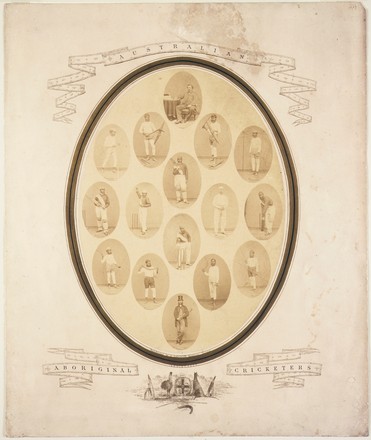Australian Aboriginal cricketers
1867
Albumen photoprint on cardboard with lithographed letterpress
Bequest of Sir William Dixson, 1951
DL Pf 140
The 16 portraits that make up this composite image were taken by colonial surveyor Patrick Dawson at his photographic studio in the Victorian town of Warrnambool in the months before the team’s departure for England. Each player was individually photographed – five of the Aboriginal team members were posed with cricket bats or stumps but most with weapons such as boomerangs, spears, clubs and shields. The captain, ex-English player Charles Lawrence, holds a ball.
Dawson assembled the individual portraits into a composite, which he also issued as a cased-ambrotype for a small-scale souvenir. The players are identified on each of the individual portraits, along with their team managers at the top and bottom. Two of the photographed players (Harry Rose and Tim Draw) did not end up going on the tour, and were replaced by Jim Crow Jallachmurrimin and Charles Dumas Pripumarraman.
Beginnings: the Aboriginal Eleven
In 1866 cricketer and footballer Thomas Wills formed a cricket team of Aboriginal players from western Victoria. With himself as captain, Wills organised two tours of Victoria and NSW. The first match was played against Melbourne Cricket Club; Wills' last match with the team was against a NSW XI, played at the Albert Ground in Redfern in April 1867.
Soon after, ex-England player Charles Lawrence, who had joined Wills in several matches with the Aboriginal team, was appointed as coach and captained the team for most of the remainder of its domestic tour. The tour culminated with a match against an Army and Navy XI in Sydney on 4–5 February 1868. Three days later the team, led by Lawrence, sailed for England.
Wills, with his brother-in-law and several others, is credited with devising the football game later known as Australian Rules as a way for cricketers to keep fit during the winter months.
Endings: the Aboriginal Eleven
During their historic tour
of England, the Australians played 47 matches against the professional English
cricketers, winning 14, losing 14 and drawing 19.
Yet after the tour only a
few of the players continued playing representative cricket. Johnny Mullagh Unaarrimin
– a talented all-rounder who scored 1698 runs and claimed 245 English wickets
during the tour – became a professional at the Melbourne Cricket Club, but
returned to his home in Harrow in Victoria after six games. He later played for
Victoria against Lord Harris's English team in 1879, top scoring in the second
innings. Johnny Cuzens Zellanach also played for Melbourne as a professional
before returning to the bush in 1870. Twopenny Murrumgunarriman played for NSW
against Victoria in 1870.



 Back to list
Back to list